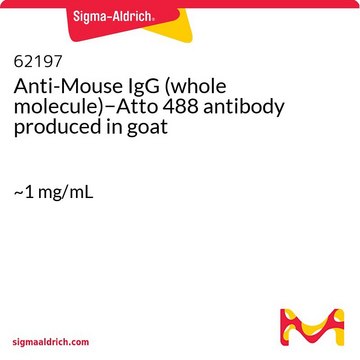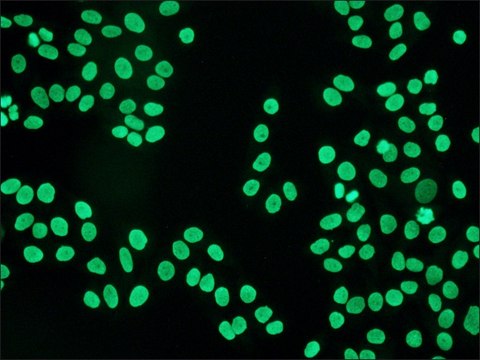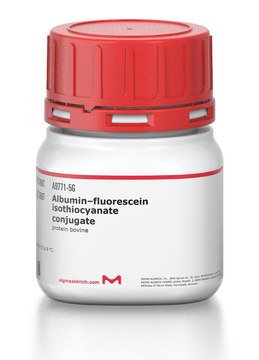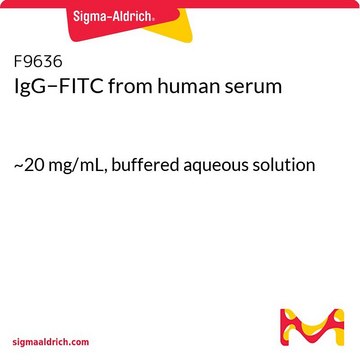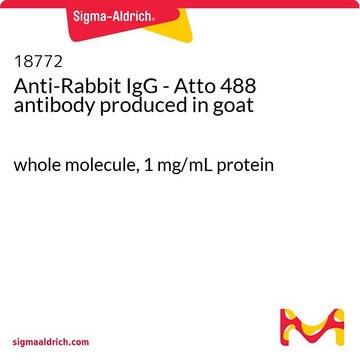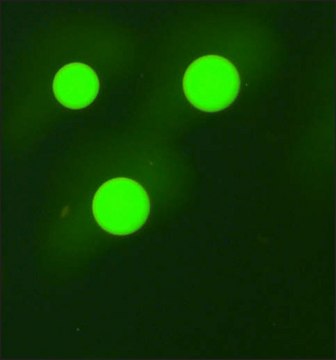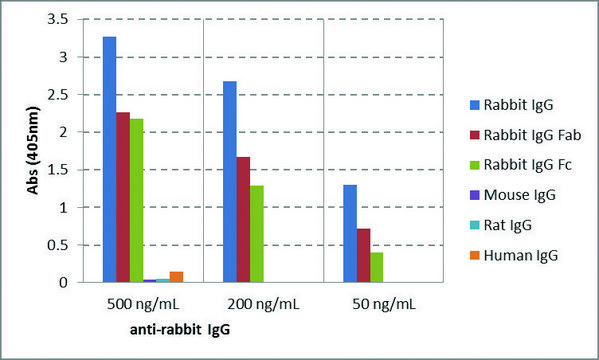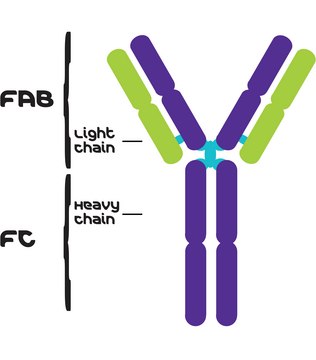52526
Anti-Human IgG (whole molecule)−Atto 488 antibody produced in goat
~1 mg/mL
Sign Into View Organizational & Contract Pricing
All Photos(1)
About This Item
UNSPSC Code:
12352203
NACRES:
NA.46
Recommended Products
biological source
goat
Quality Level
conjugate
Atto 488 conjugate
antibody form
affinity isolated antibody
antibody product type
primary antibodies
clone
polyclonal
contains
50% glycerol as stabilizer
species reactivity
human
concentration
~1 mg/mL
fluorescence
λex 500 nm; λem 522 nm in PBS
shipped in
wet ice
storage temp.
−20°C
target post-translational modification
unmodified
Related Categories
General description
Human IgGs are glycoprotein antibodies that contain two equivalent light chains and a pair of identical heavy chains. IgGs have four distinct isoforms, ranging from IgG1 to IgG4. These antibodies regulate immunological responses to allergy and pathogenic infections. IgGs have also been implicated in complement fixation and autoimmune disorders,. Atto 488-goat anti-human IgGs are known to associate with human IgGs.
Immunogen
human IgG
Application
Atto 488-goat anti-human IgG may be used for fluorescence-based immunoassays.
Physical form
Atto 488 goat anti-human IgG (whole molecule) is provided in unit sizes of 1 ml as 1 mg/ml solutions in 0.1 M sodium phosphate, 0.1 M NaCl, pH 7.5, containing 5 mM sodium azide as a preservative.
Analysis Note
unconjugated dye ≤5% of total fluorescence; dye-to protein ration ≥2
Legal Information
This product is for Research use only. In case of intended commercialization, please contact the IP-holder (ATTO-TEC GmbH, Germany) for licensing.
Disclaimer
Unless otherwise stated in our catalog or other company documentation accompanying the product(s), our products are intended for research use only and are not to be used for any other purpose, which includes but is not limited to, unauthorized commercial uses, in vitro diagnostic uses, ex vivo or in vivo therapeutic uses or any type of consumption or application to humans or animals.
Not finding the right product?
Try our Product Selector Tool.
Storage Class Code
10 - Combustible liquids
WGK
WGK 2
Flash Point(F)
Not applicable
Flash Point(C)
Not applicable
Personal Protective Equipment
dust mask type N95 (US), Eyeshields, Gloves
Regulatory Information
常规特殊物品
Choose from one of the most recent versions:
Already Own This Product?
Find documentation for the products that you have recently purchased in the Document Library.
Tianyu Wu et al.
The Journal of cell biology, 220(10) (2021-08-12)
The repetitive sequences of DNA centromeric regions form the structural basis for kinetochore assembly. Recently they were found to be transcriptionally active in mitosis, with their RNAs providing noncoding functions. Here we explore the role, in mouse oocytes, of transcripts
W Wisemandle et al.
Pediatrics, 106(1), E14-E14 (2000-07-06)
To determine the effects of timing of onset of overweight (OW) on childhood anthropometric adiposity levels using long-term serial data from the Fels Longitudinal Study. OW was defined as body mass index (BMI; kg/m(2)) >25, and the age at first
C Papadea et al.
Critical reviews in clinical laboratory sciences, 27(1), 27-58 (1989-01-01)
Human IgG consists of two identical heavy (H) chains and two identical light (L) chains joined by interchain disulfide bridges. Heterogeneity in the amino acid sequences of the H and L polypeptides results in at least three types of IgG
F Cataldo et al.
Minerva pediatrica, 42(12), 509-514 (1990-12-01)
IgG are the most common isotype of Ig and include four subclasses which differ from one another in the following ways: their initial amino acid sequence, their physical and chemical properties and the different serum concentrations reached with age. Every
Articles
Immunoblotting (Western blot transfer) is a common technique in modern proteomics research.
Our team of scientists has experience in all areas of research including Life Science, Material Science, Chemical Synthesis, Chromatography, Analytical and many others.
Contact Technical Service